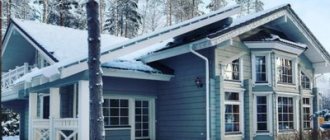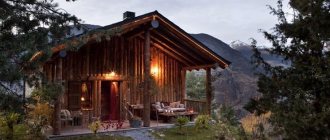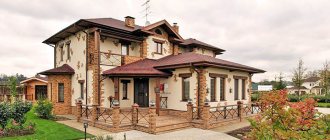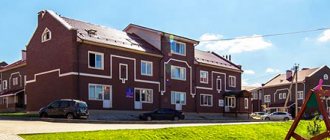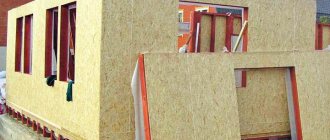Dreaming of their own home, people want to build it as quickly as possible and work hard on construction sites from spring to late autumn in order to have time to complete a large amount of work before the cold weather. Building a house in winter seems unthinkable to many, so with the onset of frost in November and early December, the process is postponed until April, which prolongs the construction time of the home.
Meanwhile, there are people who continue or are just starting to work during the cold season. They complete the process of building a house before those who like to put it off until spring. In this regard, it is necessary to consider whether it is possible to build a house in winter or whether this should not be done.
Pros and cons of building a house in winter
Advantages of winter construction
At first glance, it may seem that it is difficult to find the advantages of building a house in winter. But in fact there are quite a lot of them:
- Cost of materials and work. The winter period is considered a low season, so suppliers offer good discounts on building materials. In winter you can get a discount of up to 15%, and maybe more if you bargain well. In addition to the reduced prices for materials, you will also be pleased with the favorable cost of the work itself - construction crews are happy to take on the work, because there is not enough of it. Another advantage will be the fact that the builders will not rush to complete as many orders as possible, and can do the work better.
- Convenient access to the construction site. Construction of houses in winter can be considered convenient because... the ground freezes and is leveled thanks to the snow, which makes it much easier to transport construction materials and drive heavy equipment. In the spring, the roads wash out and turn into pure mud.
- The soil and landscape are preserved. For the reasons described above, the soil is well preserved because the ground freezes and is not exposed to much impact from heavy construction equipment. In the warm season, the top layer of soil may be damaged and it will take time to restore it.
- Construction time is reduced. By starting construction in winter, you will shorten the construction period - by spring the box will be ready and you can begin finishing.
- It is easier to work with loose soil because... he will be frozen.
- Winter is suitable for wood construction. Due to the low humidity, winter time is excellent for construction with timber/logs. Wood in winter contains less moisture, which is why it will crack less when drying. It is also more convenient to store it in cold weather - the tree will not rot and insects will not infest it. Therefore, if you doubted whether it was possible to build a wooden house in winter, it is possible, and even necessary.
- Convenient to store materials. Firstly, it’s simply cleaner in winter. Secondly, materials can be stored simply by covering them, protecting them from snow; there is no need to make pallets (which are needed so that the material does not absorb moisture from the ground).
- There are fewer neighbors in winter
because Usually everything is built in the warm season. You will not disturb anyone with the noise of construction work and dirt.
Disadvantages of winter construction
- Short daylight hours and bad weather conditions complicate the construction process.
- Additional work with concrete. In winter, concrete needs heating and special plasticizer additives, otherwise the quality of concrete may suffer due to frozen water inside the pores.
- Additional expenses. You will have to spend additional electricity for lighting, heating the cabin, heating the concrete and purchasing additives.
- It is more difficult to dig the soil because he's frozen.
- It is more difficult to carry out finishing work. Interior finishing work associated with wet processes cannot be carried out at sub-zero temperatures, and it is difficult to provide heat to a newly built house.
Construction of the foundation in winter
The foundation of a house built in winter creates some difficulties for future owners. But if you still need to urgently build a foundation, you should take into account the fact that its cost will be high. This is due to the fact that for the work you will need to purchase anti-freezing mixtures and you will need to use expensive equipment to dig frozen soil for the foundation pit.
If you plan to build your future home on a swampy or peat area, then in winter you can build a pile-screw foundation: it will cost less than other types of foundations. A strip foundation cannot be built at this time of year on clay and in places with high groundwater.
Features of winter construction
What you will need to carry out construction work in winter:
- Provide workers with a warm cabin with heating and light sources;
- Take care of heating the concrete; you will need special equipment and possibly the help of specialists. You will also need special additives for the mortar.
- When performing piling work, you will have to work hard; soil development will be necessary (mechanical or heating);
- Special additives to the brickwork mortar will be required, as well as its heating.
- It is necessary to follow special construction technology depending on the material.
Concrete work in winter
The most difficult thing in concrete work in winter is to prevent the mortar from freezing until it has gained the necessary strength. This will require the use of chemical additives that reduce the freezing point of water and accelerate the hardening of concrete, as well as heating the concrete (electric heating, heating with electrodes, infrared heating, the “thermos” method, etc.) It is recommended to maintain a positive temperature of all components of concrete.
Concrete in winter. Warming up the concrete.
Before building a house in winter, you should clearly understand the processes with which water interacts. When it freezes, it expands and turns into crystals. All processes stop. With warming, the process of cement gaining strength resumes, but with worse results. Consequently, such a concrete solution will be porous and brittle, which is not suitable for use at home.
To work with concrete at a temperature of -15 degrees, special frost-resistant additives are introduced into the solution. Due to its simplicity, this method has gained wide popularity.
Many argue that in summer the concrete solution dries very quickly, and thereby negatively affects the quality of the structure. Professionals prefer pouring concrete in winter. Because there is a gradual release of moisture, and the concrete is laid perfectly.
Pouring concrete in winter. Clickable.
Pouring the foundation in winter:
- “thermos effect”. It is created using insulation, in which the materials retain heat for a long time, and the concrete successfully matures;
— special frost-resistant additives that are introduced into the concrete solution;
- pouring the solution warm. Its temperature should be in the range of 20-40 degrees;
- artificial heating, for example, with steam, electrical appliances, using hot air, etc. The main thing here is the presence of a frame to retain heat;
— construction of a strip or monolithic foundation. The only problem here will be digging the frozen ground. But since such foundations require a small depth, this method will be quite simple;
- choice of foundation on screw piles. Easily clogged at any time of the year.
Previously, ammonia-containing additives were used, which over time are released and poison the air. Currently they are not used.
Is it possible to build a house from timber in winter?
Are houses made of timber built in winter? Of course, because building with wood in the cold season has many advantages.
Firstly, at low temperatures the wood contains less moisture, which means the likelihood of rotting is reduced. Secondly, timber dried in frost will be more durable, which will reduce the likelihood of cracks forming. It can also be noted that in winter the wood is easier to process and retains its geometric shape. Be sure to protect the material from moisture - this will preserve its properties during construction in winter.
A wooden house built in winter quickly shrinks (about two months), so in the spring you can safely begin finishing.
Difficulties in carrying out excavation work
It happens that circumstances force excavation work to be carried out in winter. If you find yourself in exactly this situation, then consider the following points:
- The soil should be prepared while it is warm outside. This preparation means draining the soil, because it is wet soil that freezes. The desired result can be achieved by installing drainage ditches around the perimeter of the building site. There are other ways.
- The simplest and most effective method is to saturate the soil with salt solutions. By combining with water in the soil, salt increases its heat capacity. Thermal conductivity also decreases, which leads to a decrease in the freezing point. It is necessary to sprinkle the land with salt during the autumn rains so that the water that goes into the ground saturates the ground to the required depth.
Salt prevents water from freezing
. Tip! If the building site is very large, it will take a lot of salt to salt it out. It is much easier to use the following method, especially considering that the material suitable for this can then be used to insulate a house.
- We are talking about insulating the soil, which will prevent it from freezing during frosts. It is produced using extruded polystyrene foam and dense mineral wool. The latter material is afraid of water, losing its thermal insulation properties, so it must be additionally covered with a waterproofing film.
From the author! The disadvantage of this approach is that by the time the construction time comes, all the insulation can be stolen by unscrupulous enterprising citizens. To prevent this from happening, simply hide the material from view by sprinkling some soil on top of it.
- Another popular method is plowing and harrowing. In warm weather, the soil is plowed to its maximum depth, then the top layer is harrowed. This effect saturates it with air, which is an effective insulation. In fact, a fur coat is created that covers the thickness of the earth from freezing. Very effective, and most importantly, cheap.
Soil development in winter is difficult
- The last method will be good for those who are not prepared at all. The soil is artificially heated and then removed layer by layer. For this purpose, special power stations are used. This method is the most expensive and is used very rarely for private construction.
Is it possible to build a house from aerated concrete in winter?
Aerated concrete is not the best material option for winter construction. Points to take into account:
- It is necessary to heat the gas blocks, otherwise the water and glue will freeze;
- The gas blocks will have to be watered with almost boiling water, otherwise the water will immediately freeze;
- Do not place gas blocks on ice;
- Do not heat the mixture with boiling water - the cement will lose its properties;
- You will have to keep the glue in a container with thick walls and a lid, otherwise it will quickly freeze. It also needs to be diluted with hot water, but not boiling water;
- Waterproofing of the material is necessary, since moisture inside the aerated block when freezing can damage its integrity.;
- Finishing of aerated block facades is definitely necessary, because... cellular material is afraid of dampness.
Laying walls.
Masonry can be done in any weather conditions, regardless of the time of year. But it is necessary to take into account some features. Let's look at them.
Features of masonry in summer and winter. Clickable.
The marking of the concrete used is of great importance on the quality of the concrete mixture. It is recommended to use concrete marking M500 and higher.
Is it possible to build a brick house in winter?
Building brick houses in winter is quite common. The same difficulties arise here as with any winter construction. Therefore, whether to build brick houses in winter is up to you. Things to consider:
- It is necessary to use modifiers to reduce the freezing threshold;
- It is necessary to constantly thoroughly clean the brick from snow and ice;
- As mentioned above, do not heat mixtures with boiling water;
- It is not recommended to carry out facing masonry in winter;
- Use solutions with a grade one or two higher than the design one (depending on the air temperature).
- It is better not to use cement of a grade lower than M500
Interior decoration in winter
If before the frost a person managed to put up a box, make a roof and install windows, the next step will be the interior decoration of the house. If there is no heating in the room and the temperature is below 5°C, it is not recommended to carry out the following work:
- Level the walls with plaster, as it is destroyed in frosts.
- Glue wallpaper to the walls and attach suspended ceilings, as they will bubble when there is a change in humidity.
- Cover the walls with plasterboard: they will crack and become deformed.
In winter, in an unheated room, you can:
- lay brick partitions;
- cover the walls with clapboard;
- make subfloors;
- decorate the walls with plastic panels;
- install metal structures (stairs, doors);
- lay linoleum on the floor.
It is better to postpone all other work until spring.
What is the best house to build in winter?
Let's highlight building materials that are used in any season:
- Thermoblocks are concrete in permanent formwork made of polystyrene foam boards. The advantage of the material is that the formwork walls protect the concrete from rapid heat loss, which is necessary for its uniform hardening.
- Any metal structures that are connected by welding.
- SIP panels and wood can also be used in winter. They undergo special processing and are stored in special conditions, so they do not need thorough drying.
Advantages of winter construction of a brick building
- In cold weather, as in hot weather, cement hardens (gaining maximum strength) within 28 days. In frost it can only freeze, because there simply cannot be excess evaporation of moisture. Drying and the appearance of microcracks and cracks in the mortar can only be observed in summer, when direct sunlight and high temperatures with low air humidity promote drying, rather than hardening, of concrete joints between bricks.
- According to masons, winter masonry is considered the most durable . In ancient times, when villagers were plowmen, plant growers, and livestock breeders in winter, they built brick houses mainly in winter. True, bricks were made in summer and autumn, before the start of the rainy season. This is how they used last year’s straw and other organic matter to insulate homemade silicate building material. Nowadays such a plus is rarely used in using last year’s natural insulation.
- The consumption of cement mortar in winter is reduced as a result of its strict dosage. The mortar is not applied to either the tray or the bond side of the brick, and to cover the previous row of bricks, a limited amount of binder mortar is used on the trowel, although it does not spread.
- One of the most pleasant advantages for a builder is that insects do not fly in winter . The absence of bites and the presence of midges in the eyes significantly reduces the laying time, just like frost - if you don’t move, you’ll freeze.
- Microcracks in bricks cannot contain water , which, when expanded, can lead to deformation and serious damage. It already contains ice, and when it melts there will be no harm to the material.
- The material that has undergone deformation during storage technology violation is immediately visible . It is easier to reject it and not use it for masonry. Construction work under positive temperature conditions does not provide such a guarantee. Moisture trapped in the cavities, when the air temperature drops below zero mercury, will begin to expand and lead to deformation of more than one fragment of the masonry.
Practical advice
For those who don’t know at what temperature it is possible to lay brickwork outside, experts still advise using summer time as much as possible. The fact is that construction in winter reduces the quality of the masonry, and financial costs increase by about thirty percent.
Before laying bricks in the cold with the addition of anti-frost additives to the masonry mixture, purchase cement material M 300 for preparing the mortar. It will improve the technical parameters of hardening.
If the construction of premises is underway, the operation of which is planned in conditions of high humidity, adding PMD to the mortar mass is strictly prohibited, since the sand-cement mixture will lose its strength.
The thickness of the mortar joint can be maintained at no more than twelve millimeters. Otherwise, during the thawing process, the solution will behave unpredictably, violating the integrity of the masonry.
Is it possible to build a brick house in winter? Yes, only the speed of laying brick stones should exceed the operating mode for the summer season.
In the event of a break in work and frosty weather, when resuming masonry, it is necessary to warm up the upper brick rows using a construction hair dryer. To save time on heating, it is recommended to insulate the laid rows after finishing work.
Is it possible to do masonry when the air temperature drops below twenty degrees below zero? Remember that for such temperature conditions it is best to pause the masonry process.
When performing work using the freezing method, you should not skimp on reinforcement. It is recommended to install reinforced concrete elements over window and door openings.
When carrying out masonry work in winter, special attention is paid to controlling the position of rows vertically and horizontally.
When is the best time to build a frame?
Builders who build a house for themselves often divide the entire process into several seasons. This is related to finances, because there is no desire to take out loans, and it is impossible to allocate a lot of money for construction at once. And over time, don’t quit your job because of building a house. Therefore, framers raise themselves with their own hands at different times of the year during vacations, weekends and free time.
Let's see which stages of frame construction are best done at different times of the year.
For example, if the frame is being built independently, then it is better to pour the concrete foundation at the beginning of summer: it is not yet hot, but not rainy either. After all, the base must be kept constantly moist and not allowed to dry out, which is difficult in the middle of summer. This does not apply to a pile foundation; it can be installed at any time of the year.
It is better to install the frame-box yourself in the summer before the autumn rains or in the winter during severe cold - these are the driest periods.
The roof can only be covered during warm periods - soft roofing materials can withstand work only down to -5 degrees. But in the summer it is difficult to cover the roof, because the same materials get very hot. But before wet days, the house needs to be covered so that neither rain nor snow gets inside.
Insulating a house can be done in summer or winter, when the perimeter of the house is already closed and windows and doors are installed. High humidity during wet seasons spoils the insulation - it absorbs a lot of moisture, creating a favorable environment for mold.
As you can see, the main work can be done in winter. In the summer there are always other things to do - work, relaxation, dacha, fishing, mushrooms.
If you plan to build a frame frame in the winter with a construction crew, then there is no deadline for them. The only advantage of working as a team in winter is saving time and money.



